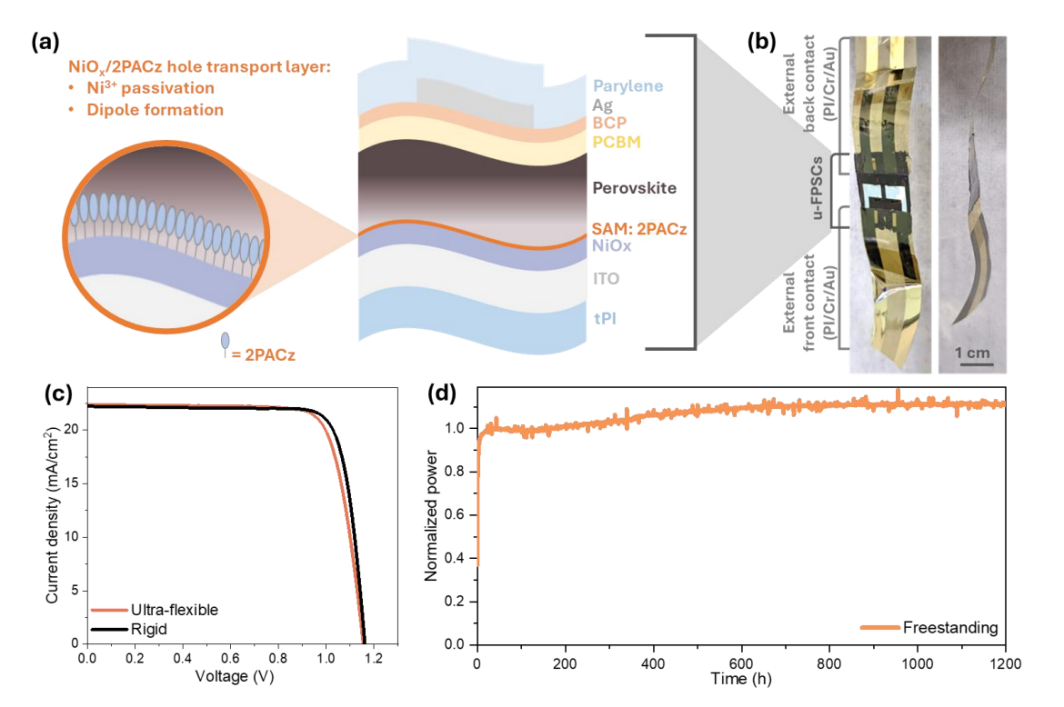Professor Yabing Qi Publishes in Joule: Breakthrough in Ultra-Flexible Perovskite Solar Cells Achieve 20.3% Efficiency with Dual Hole Transport Layer
In November 2025, Professor Yabing Qi from Global Institute of Future Technology and Zhangjiang Institute of Advanced Study in Shanghai Jiao Tong University, in collaboration with research teams from the Okinawa Institute of Science and Technology Graduate University (OIST), the University of Tokyo, Osaka University and RIKEN, achieved a critical breakthrough in ultra-flexible perovskite solar cells (u-FPSCs). The paper titled "Dual hole transport layer for ultra-flexible perovskite solar cells with unprecedented stability", was published online in the journal Joule. The research provides core technological support for lightweight energy devices in fields such as the Internet of Things (IoT), avionics, medical monitoring, etc.
This paper proposed a dual hole transport layer (HTL) structure integrating nickel oxide (NiOx) and a carbazole-based self-assembled monolayer (2PACz). This addresses the long-term challenge of balancing efficiency and stability in u-FPSCs. The NiOx nanoparticles, processable at a low temperature of 100°C, minimize thermal damage to the transparent polyimide (tPI) substrate and ensure a conformal coverage of perovskite film. Meanwhile, the 2PACz monolayer precisely modulates the interface dipole, enabling the valence band of NiOx better aligned with that of the perovskite material. This significantly reduces non-radiative recombination losses at the perovskite interface, and results in a higher VOC up to 1.15 V, laying a crucial foundation for high performance.

Figure 1 - u-FPSCs structure and performance
Ultra-flexible perovskite solar cells are typically fabricated on substrates thinner than 10 μm to achieve lightweight and excellent mechanical flexibility. However, conventional devices face two major bottlenecks: First, indium tin oxide (ITO), a kind of rigid transparent electrode, is prone to cracking under deformation; Second, rapid degradation of perovskite materials by moisture and oxygen. Most previously reported u-FPSCs showed power conversion efficiencies (PCE) below 20% and device stability generally under 50 hours.
To tackle these challenges, the researchers implemented a dual innovation strategy. First, through optimization of electrodes and transport layers, they used a 2.1 μm thick tPI substrate combined with a 130 nm thick amorphous ITO electrode and the NiOx/2PACz dual HTL. This enabled a small-area (0.04 cm²) device to achieve PCE of 20.3%. Second, for enhanced protection, the researchers utilized the atomic layer deposition (ALD) to prepare a 15 nm thick bilayer of aluminum oxide (Al₂O₃) and parylene-C. This encapsulation allowed the device to retain 90% of its initial PCE after 130 hours, and 80% after 260 hours, under ambient air conditions (50% relative humidity and room temperature). Notably, the 15 nm Al₂O₃ layer only reduced the specific power from 27.6 W g⁻¹ to 27.2 W g⁻¹, a decrease less than 2%. Furthermore, the device maintained over 95% of its initial PCE after 1000 bending cycles (with a 5 mm radius) and folding tests, demonstrating exceptional mechanical durability.

Figure 2 - flexibility and stability results for u-FPSCs
PhD student Ilhem Nadia Rabehi and Dr. Silvia Mariotti from OIST are the co-first authors of the paper. Professor Yabing Qi from Global Institute of Future Technology and Zhangjiang Institute of Advanced Study in Shanghai Jiao Tong University is the corresponding author. Collaborating institutions also include Osaka University, RIKEN, etc. This research received support from Global Institute of Future Technology and Zhangjiang Institute of Advanced Study in Shanghai Jiao Tong University, OIST, KAKENHI, etc.
Paper Link: https://doi.org/10.1016/j.joule.2025.102209
Professor Profile

Yabing Qi
Yabing Qi is a Chair Professor at Global Institute of Future Technology / Zhangjiang Institute of Advanced Study in Shanghai Jiao Tong University, and a Foreign Fellow of the Engineering Academy of Japan. Prof. Qi obtained his B.Sc., M.Phil., and his Ph.D. degrees from Nanjing University, Hong Kong University of Science and Technology, and University of California Berkeley. From 2008 to 2011, he conducted postdoctoral research at Princeton University on the application of surface and interface sciences in organic semiconductors. From 2011 to 2024, he was a faculty member at the Okinawa Institute of Science and Technology Graduate University (OIST) in Japan, where he had an early promotion to tenured Full Professor, leading the Energy Materials and Surface Sciences Unit as the Unit head. In 2024, Prof. Qi joined Shanghai Jiao Tong University as a full-time Chair Professor.
Over the past two decades, Prof. Qi has made outstanding contributions to surface science and energy materials. In 2022, he received the Kao Science Award from the Kao Foundation for Arts and Sciences in Japan. In 2023, he received the JSPS Prize. In 2024, he was elected as a Foreign Fellow of the Engineering Academy of Japan.
As a distinguished scholar in the fields of surface sciences and energy materials, Prof. Qi has published over 200 SCI-indexed papers in internationally renowned academic journals. He has an H-index of 86 and total citations exceeding 30,000. Since 2021, he has been selected as a Clarivate "Highly Cited Researcher" for five consecutively years. He is also a Fellow of the Materials Research Society (MRS Fellow), a Fellow of the American Vacuum Society (AVS Fellow), and a Fellow of the Royal Society of Chemistry (FRSC).
Prof. Qi's research spans multiple disciplines including materials science, physics, chemistry, and electrical engineering. He plans to establish an internationally competitive multidisciplinary research center at Shanghai Jiao Tong University based on surface sciences and advanced materials, applying fundamental surface science research to the development of energy and functional materials and devices, such as solar cells, lithium-ion batteries, organic electronic devices, light emitting materials, providing crucial technical support for the future development of energy technologies.




